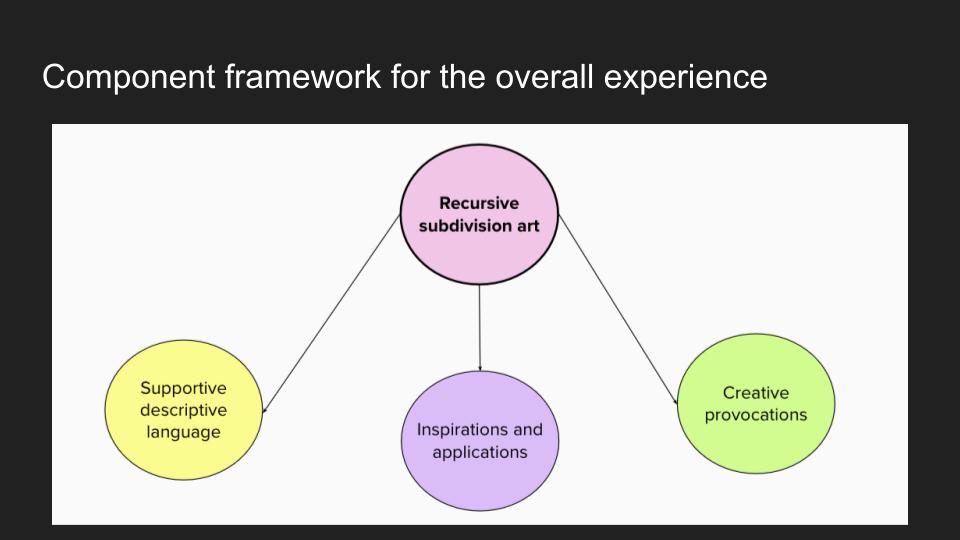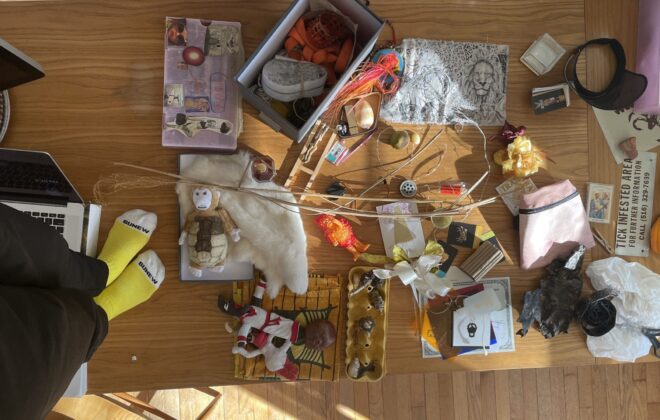Week 9 – Reflection on feedback, MVP specs and updated benchmarks


This week I was lucky enough to share my project idea and a very simple prototype with 3 different people during our class session. I focused mainly on showing my rough prototype and describing my more recently developed general framework for the experience. They all had very helpful questions and suggestions. Here is a short summary of their comments and a few of my main takeaways:
Comments/Questions:
Audience:
- It seems like you have some sophisticated ideas that would make this interesting to adults.
- Perhaps your audience is creative souls
User Journey:
- What is the hook, that initial “Holy $#%&!!!” moment that draws them in and commits them to engaging?
- What is the story being told?
- How can you connect what is being made to the story?
Experience Design
- Have you thought about sound design?
- Can you initially narrow to a single theme to not overwhelm? — for example trees
- Can you choose one focus to tie things together? — for example fractals
- How might you take the experience off the screen?
- Could sliders become movement or motion of the body?
Takeaways
- I should definitely think about that initial moment that hooks them. When does it happen? Is it a demo or a moment in their own creative process?
- Sound design — yes….definitely
- I’m a little unsure about this idea of ‘telling a story’ or ‘narrowing my focus’. I can see why it might be important but there are definitely things that I don’t want this to be about. To say this about fractals, recursion or patterns in nature seems to miss the point of what I’m going for. This seems like a really important question because context and framing will shape a person’s expectations about what they are doing there and what they might get out of the experience. So what do I want them to get out of it?
This last point seems really important and led me to articulate the following elaboration:
I don’t think the goal of this is conceptual, the primary goal is to engage them in an interactive art experience. Thus the overall goal seems similar to that articulated by the Tinkersynth project (https://tinkersynth.com/faq).
However, this is a particular experience of making art that is characterized by the following characteristics:
- Uses dynamic geometry and subdivision, a specific set of unique tools and materials — similar to spin art, spirograph, LEGO or doodling.
- Uses a generative rule system (algorithm) but there is a tremendous amount of individual decision making that goes into the process — each piece is unique.
- Uses a process that produces emergent patterns from simple rules
- Uses a process of decision making that allows you to make aesthetic choices about what form or pattern is more interesting or beautiful to you.
- Uses a supportive descriptive language to help structure your observations of your art and the world around you.
A major takeaway from this reflection and some of the research that I’ve been doing looking at similar generative art projects and their UX/UI is that I think that it might be helpful to conceptualize this experience as analogous to purchasing a process art kit such as Spirograph, Spin Art or even LEGO. The focus is on providing a unique but limited set of tools and materials and then allowing for creative play. By providing a rich and engaging experience the 5 elements listed above will be embedded in the experience but they are not necessarily how the user is consciously framing the experience.
Specs for a minimal viable product
My goal for this term is to have a minimum viable product completed so I can use the summer for re-evaluating and taking a 2nd pass at a design cycle to produce v2.
With about a month left, I wanted to nail down my target specs for this iteration of the project to help with project planning and prioritization. My goal is that the version that I present at the end of the semester will have the following components:
- One interactive example of the generative artifact that you can interact with to understand both the algorithm and explore possible decorative techniques
- This interactive example will consist of a repeatedly subdivided square with draggable points
- A design dashboard will show analytics about the design produced including a count of objects drawn and a histogram of areas.
- There will be 1-3 options for decorating which may include – color, line weight, hand-drawing an insert, inserting an image, options for varying termination depths
- 5 cards that demonstrate Alexander’s geometric properties or similar concepts
- 5 cards that provide inspiration images or creative prompts
Updated project benchmarks
Based on my specs, what I have now and the remaining class schedule, I’ve developed these personal benchmarks in addition to the ones in the class.
CLASS 9: WEEK OF APRIL 12
- Complete analysis of 10 other related UX/UI
- Add dynamic geometry functionality to rough prototype
- Add one way to artistically customize the output to rough prototype
- Add one way to visualize the output on dashboard to rough prototype
- User journey narrative (about 500 words)
CLASS 10: WEEK OF APRIL 19
- Create wireframe mock-up of full final UI
- Create 1 sample inspiration card and concept card
- User testing in Feedback Collective and class with rough prototype
CLASS 11: WEEK OF APRIL 26
- Add visual and sound design elements to rough prototype
- Complete ‘bare bones’ slides
- User testing with full MVP
CLASS 12: WEEK OF MAY 3
- Finish presentation and present
Related Posts
Leave a Reply Cancel reply
You must be logged in to post a comment.
Kat Sullivan
Adam Colestock
Helen (Chenuan) Wu
Christina Lan
Dorian Janezic
George Faya
Julia Myers
Kelsie Smith
Michael Morran
Po-Wen Shih
Liu Siyan
Fisher Yu
—
Craig Protzel
Christopher Wray
Haoqi Xia
Hayden Carey
Katherine Nicoleta Helén
Maria Maciak
Parisa Shemshaki
Sakar Pudasaini
Skyler Pierce
Steven Doughty
Yiqi Wang
—
Andrew Lazarow
Benoit Belsot
Enrique García Alcalá
Hongyi Zhang
Jay Mollica
Li Shu
Teddy (Jian) Guo
Monika Lin
Wenye Xie
Yiru Lu

